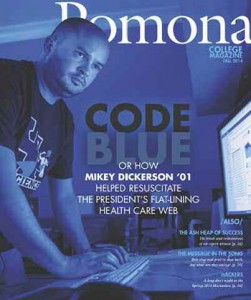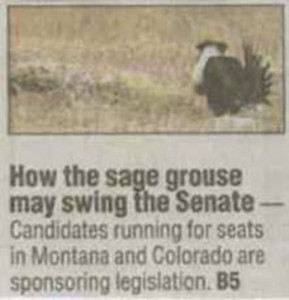PCM: Thumbs Up
 After a near 50-year hiatus from contact with the College, I am now re-engaged. Two obvious factors have been the 50th–Year Reunion and the College’s email listserv. A third factor is your excellent publication. Very professional in layout and content. I suspect this may play a role in the increasing recognition of the College in national publications.
After a near 50-year hiatus from contact with the College, I am now re-engaged. Two obvious factors have been the 50th–Year Reunion and the College’s email listserv. A third factor is your excellent publication. Very professional in layout and content. I suspect this may play a role in the increasing recognition of the College in national publications.
—Jerry Parker ’64, Olympia, Wash.
Thanks for the years of editing PCM—I have copies from the ’50s that look like the monthly tool store “what’s-on-sale” mailings. What a change! For me, I would like to see more on the current faculty and profiles of what graduates have accomplished to be a “tribute to Christian society.” (This used to be on each tea bag in the ’50s.) Harvard asks for voluntary contributions, which I have maintained over the years, and you can plan on a steady, small, but constant stream from me. All best wishes for the next 16 years.
—H.G. Wilkes, Hingham, Mass.
Thank you for your letter regarding the Pomona College Magazine. I thought the recent issue was excellent—particularly the article “Ash Heap of Success.” Thank you, Professor Seligman.
—Ellen Walden Hardison ’44, Corona, Calif.
I was in Claremont visiting my sister at the San Antonio Gardens, and one evening we decided to visit the Skyspace installation by James Turrell. I keep most of my old PCMs, and so I found the Winter 2008 publication and was able to read some of the background about the Skyspace. What a wonderful experience. We enjoyed viewing the colors as they progressed after sunset. The night sky changed colors too!
Keep up the good work and thanks.
—Barbara McBurney Rainer ’53, Carmel, Calif.
 Commentary on PCM, Fall 2014: For some of us, coding is a means to an end, not an end in itself. It has to be continually upgraded. A while ago, I wrote a large number of papers on wavelets, but only as long as I had access to MATLAB’s Wavelet Toolbox.
Commentary on PCM, Fall 2014: For some of us, coding is a means to an end, not an end in itself. It has to be continually upgraded. A while ago, I wrote a large number of papers on wavelets, but only as long as I had access to MATLAB’s Wavelet Toolbox.
“The Ash Heap of Success” is a patent dispute (for lawyers). However, the DNA diagrams were marvelous. (I postdoced in DNA.)
DIY Physics: lab projects for electronics; they are confined to mechanics, which makes good sense. A photonics lab might be useful also, using lasers for the same applications.
Keep up the good work.
—Katharine J. Jones, Ph.D., Class of 1961
PCM: Thumbs Down
 I have wanted to write this letter for some years, but your August 29 letter, along with the current issue of Pomona College Magazine, prompted me to write you immediately.
I have wanted to write this letter for some years, but your August 29 letter, along with the current issue of Pomona College Magazine, prompted me to write you immediately.
If the magazine is in such a financial situation that it has to nickel and dime the alumni to keep going, I have a strong suggestion for you—the same suggestion I have been holding for some years: Cut back!
Let me also put your request in the context of last week’s New York Times article which states that Pomona College’s endowment sits at more than $1 million per student.
The production of the magazine, which has to be extremely costly, is way overblown. If you cut back on paper quality, make it a smaller size—both in measurement and number of articles (nine-plus in this issue; you could do with half that)—but most of all, scale back the DESIGN, the savings would be substantial.
The magazine is so over-designed that it becomes difficult to read. Where is your eye to focus? Where does the article start? Are the sidebars relevant? For those of us slightly older folks whose eyesight is beginning to fail, the type size of many of the articles is too small, and the color tone is slightly lighter than other comparable magazines. The heavy, slick paper makes it harder to read, causing reflections. It is also more difficult to recycle. Perhaps it is time to give alumni the option of receiving all issues online.
I would much rather have my donation to the College spent on tuition relief for a needy student than on a fancy, overdone magazine.
—Susan Hutchinson Self ’62, Santa Rosa, Calif.
Clearer heads didn’t speak up for goodness sakes? A letter announcing the launching of a “voluntary subscription program” has arrived with this latest edition of the Pomona College Magazine. Putting aside the increasingly slick and unnecessarily thick stock chosen for recent publications, let me address my deep aversion to the ploy of “voluntary subscription.” I quote: “everyone will continue to receive PCM whether or not they give.” How very kind of you.
Didn’t anyone realize that such a ploy disenfranchises? Has anyone heard about the unemployed, about fixed incomes further dwindling, about the broader economic chasm experienced by, yes, even Pomona College graduates? You propose the 1% “subscribe.” Even if I were a member of that group I would still be writing this letter because I question whether your need to win accolades has become more important than the mission of maintaining a link with ALL Pomona College graduates. May I respectfully suggest someone needs to put on the brakes.
—Silvia Pauloo-Taylor ’57, Tinton Falls, N.J.
PCM: Thumbs Green
The most recent issue of the Pomona College Magazine is very nice looking, as always, but I was distressed that it was mailed in a plastic bag in order to include the letter asking for funding and the mailing envelope. This could have been easily avoided! It is more difficult in many communities—if not impossible—to recycle plastic than it is paper. Stapling in the envelope, including the letter in the text of the magazine, would have worked very well.
I also noticed that while you do use paper from “responsible sources,” you could go much further to limit the publication’s impact on the environment. I know recycled paper can be more costly and doesn’t always look as nice, but I suspect your audience would forgive you for that. Please include environmental concerns in your aesthetic decisions. In our house, we do almost all of our reading online anyway.
—Ellen Wilson P’15, Pittsburgh, Pa.
Editor’s Note: Sustainable printing is not as simple as it may appear. Some aspects of the matter are counterintuitive. For example, coated paper kills fewer trees than uncoated paper, because it uses less wood pulp and more clay. And recycled sheets may come from Europe or Asia, with a huge carbon footprint. Add to that the fact that there is no reliable certification process for recycled papers to ensure that their production is truly environmentally friendly, and you have a difficult puzzle to solve. The best solution we’ve found so far is to use printers overseen and audited by the Forest Stewardship Council (FSC). This means the paper they use in printing the magazine comes from a mix of recycled waste and sustainably harvested (and monitored) forests. It also means the printer uses environmentally friendly chemicals and inks. —MW
 Sagehen Senate
Sagehen Senate
I graduated from Pomona 58 years ago. The world has changed since then. Astronauts have landed on the moon, and I have experienced the Vietnam War; the Civil Rights movement, Women’s and Gay Movements; and the development of the computer age. But I never thought that I would see the day that sagehens, and their male counterparts, the sage grouse, might determine which political party will control the Senate after the forthcoming elections.
My wife and I live in Bend, Oregon, during the summers. Yesterday the following lead-in appeared on the front page of the local paper. (See below.) Upon seeing the lead-in, I wondered if the sage grouse might be related to the sagehen, so I read the entire article. I learned that the sagehen is the female of the sage grouse species. Seemingly, the candidates for Senate in Montana and Colorado have differing views on whether the sage grouse species should or should not be on the federal endangered species list, and that this issue might indeed determine the composition of the Senate after the fall elections.
I had a convertible during my senior year at Pomona, and the rally committee asked me if I could transport Cecil the Sagehen to the night Pomona-Caltech football game which was being held in the Rose Bowl. We managed to squeeze Cecil into the back seat of my car, and I set out for Pasadena. I couldn’t go more than 20 mph because the wind might damage the Bird, so I wandered through the back roads of Monrovia, Arcadia and Altadena. At one point a motorcycle officer pulled up alongside me at a stop sign. I thought he wanted to give me a ticket for some type of violation, but after looking at me and the Bird with a puzzled expression on his face, he roared away.
—George E. Sayre ’56, Bend, Ore.
Sad News
I was saddened to read of Professor Emerita Margery Smith Briggs’ death just 12 days shy of her 99th birthday.
When I was a freshman, 50 years ago, my first class at Pomona College was elementary music theory, taught by Mrs. Briggs. It was the most difficult class that I ever had either at Pomona or later at Yale. As a teacher, Mrs. Briggs was enthusiastic, demanding, hard-working, organized and inspiring. She expected excellence from herself and from her students.
When I eventually began my own career as a college professor, the first class that I taught was elementary music theory. Then and ever after, I kept the energetic, inventive, dedicated example of Mrs. Briggs before me as a positive paradigm of teaching and personhood.
Over the years, I kept in touch with Margery. We often spoke on the phone, and I saw her in Claremont a year before her death. She was, at the age of 97, bright, engaging, filled with philosophical, musical and historical insights. Always independent by nature, she was still driving and insisted on taking us out to lunch at one of her favorite restaurants.
—David Noon, ‘68, New York, NY
Art on Campus
May I congratulate you and your staff on conceiving and designing the attractive new Pomona College Calendar. It is one of the best I have seen, and aptly demonstrates not only the College’s dedication to art, but also how much its chosen artworks add distinction to the College.
But not everyone appreciates art in the same way, and disagreements about what constitutes good art have not always come down on art’s side in Pomona’s history.
In the spring of1953, Walker Hall had been open about a year. Its lounge was a happy gathering point for those who appreciated a view across a green expanse that perfectly framed Mt. Baldy. It must have been one of those persons who had an idea: Why not place a sculpture in front of the huge new window? In any case, I was at a meeting of the Associated Men Students’ Council when that idea was proposed. Specifically, why not use a $5,000 surplus in the AMS budget to commission a sculpture for the area outside Walker Hall? Even more specifically, the individual floating this proposal seemed to have a commitment from the sculptor Isamu Noguchi to install one of his pieces there for $10,000. AMS approved the idea, and through the Dean of Students, asked that the trustees come up with an additional $5,000 for the project.
Later I talked to the Dean Shelton Beatty (or possibly his assistant, Bill Wheaton) after word had come down that the Board had not granted the requested matching money. Why, I asked, had that happened? One prominent trustee, the Dean said, had opposed the idea, even going so far as to offer, by contrast, a donation of $5,000 to “paint over Prometheus.” That last bit is hearsay, to be sure, and may have been spoken in jest. But clearly Pomona missed out on a Noguchi to go along with its other distinguished artworks. Over the years I have seen a number of Noguchi sculptures. One has stuck with me: it looked a bit like a rocket ship ready to take off. I wondered if that was the piece Pomona missed out on and thought, even then, how stunning it would have looked next to Walker Hall.
One other event was not a miss: Prometheus is gloriously with us. But a collection of incidents adds humor to the creation of Orozco’s masterpiece. My parents were missionaries in Mexico (where I was born) and they knew Orozco personally. They may have heard this story from him and told it to me, or I may have heard it as a student at Pomona. The trustees and Pomona’s president viewed Prometheus as it neared completion and objected to scenes of writhing naked bodies. Orozco angrily effaced the bodies with a strident blue color, a clashing, almost insulting contrast to the colors in the rest of the fresco. The blue is very much still there. Orozco also asked for more money and was turned down. His next commission was at Dartmouth College where, among other scenes, he depicted a group of robed academics at the gates of Hell. Apparently the faces of the first two figures are identifiable as those of the president of Pomona and of the chairman of Pomona’s Board of Trustees.
Art’s price is paid in differing currencies!
—Charles B. Neff, 1954, Mercer Island, Wash.
Hail Pomona! Thank you for the calendar. I took the time, at last, to really look at it. I’m curious about Peter Shelton ’73—the artwork “GhandiG” for July 2015. Is he related to Hal, John, or Marty, who were old Pomona artists, professors, etc.? I have three or four Hal Sheltons hanging here and one Joe Donat, also Pomona. They were 1930s to 1940s—before the ’70s, but certainly could be related.
The map was useful but could have been larger, easier to read and locate—especially better names for buildings on sites for an old dame of 98 years.
Art is delightful. I miss the staged “artistic” performances that melted away with traditions such as the classic Plug Ugly, done annually by faculty and the other traditions that produced “Hail, Pomona, Hail—May thy sons and daughters sing praises of thy name, praises of thy fame ’til the heavens above shall ring—” etc.
“Hail, Pomona” became our standard greeting for a long time—still is with me. An operation that I had about a year ago began with that. The MD performing the operation also was a Pomona graduate.
So—Hail, Pomona!
—Mollie Miles, Portland, Ore.
[Calendar Erratum]
In the 2014–15 Pomona College Engagement Calendar, which was sent to all Pomona College donors last summer, the date for Ash Wednesday was mistakenly listed as March 18, 2015. The correct date is February 18.
[Alumni and friends are invited to email letters to pcm@pomona.edu or “snail-mail” them to Pomona College Magazine, 550 North College Ave., Claremont, CA 91711. Letters are selected for publication based on relevance and interest to our readers and may be edited for length, style and clarity.]
